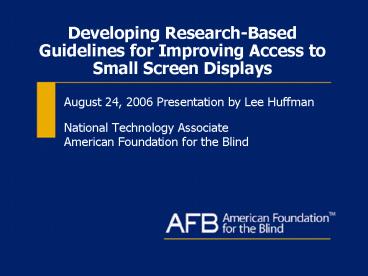Developing ResearchBased Guidelines for Improving Access to Small Screen Displays
1 / 13
Title:
Developing ResearchBased Guidelines for Improving Access to Small Screen Displays
Description:
Developing Research-Based Guidelines for Improving Access to Small Screen Displays ... designers and to help them ask the right questions than to provide specific ... –
Number of Views:39
Avg rating:3.0/5.0
Title: Developing ResearchBased Guidelines for Improving Access to Small Screen Displays
1
Developing Research-Based Guidelines for
Improving Access to Small Screen Displays
- August 24, 2006 Presentation by Lee Huffman
- National Technology Associate
- American Foundation for the Blind
2
The Problem
- Small screen displays are difficult to read!
- Small Screen displays are EVERYWHERE!
3
Some Devices That Use Small Screen Displays
- Telephones
- Office Equipment
- Self Service Kiosks
- Electronic Equipment
- At Home Medical Devices
4
Why Are Small Screen Displays Difficult to Read?
- Lack of an industry standard
- Lack of research based guidelines for
manufacturers to follow
5
Existing Guidelines
- The development of guidelines is seriously
hampered by the sparcity of sound scientific data
about the needs of people with disabilities,
John Gill - The role of these (TRACE) Guidelines, then, is
more to raise the awareness and understanding of
designers and to help them ask the right
questions than to provide specific answers or
numbers, TRACE - The (TIA) guidelines are based on current human
factors and disability literature as well as
current design practices, TIA Access
6
Developing Research-Based Guidelines for
Improving Access to Small Screen Displays
- Research Objectives
- Phase 1 Develop display measurement capability
- Phase 2 Conduct a visual performance study using
people who are visually impaired - Phase 3 Publish research findings in order to
advocate for accessibility
7
Display Metrics
- Video Electronics Standards Association (VESA)
- 5 Key Visual Display variables
- Contrast (The most important variable)
- Font
- Illumination
- Glare
- Hue
8
Optical Instrumentation for Obtaining Display
Measurements
- Digital Camera
- Iriss (2)
- Integrating Sphere
- Spectrometer
- Radiometric Calibration standard
9
Predicting a Displays Required Contrast
- By obtaining a displays level of contrast and a
persons contrast sensitivity level, one should
be able to predict whether a display will be
readable. - A visual performance study can be used to verify
predictability for a variety of visually impaired
individuals.
10
Phase 2 Visual Performance Study
- This study is to determine to what extent
character recognition in small screen displays
correlates to displayed contrast levels. - A strong correlation could serve as a key
guideline for designing accessible small screen
displays.
11
Phase 2 Visual Performance Study
- Fifty people with known Contrast Sensitivity
levels, each having different levels of best
correctable vision, will be asked to identify
characters on a display. - The percent of correct responses will be recorded
for each person for each image.
12
Phase 3 Publishing Research Findings
- In order to gain the attention of industry, the
research findings will be published in scientific
journals.
13
ConclusionOne Step Closer to Accessibility
- Armed with a standard and measurement data that
identifies the limitations of existing displays,
consumers and advocates will have the leverage to
push manufacturers toward accessibility.









![Industrial Report on Global ePaper Display Market [2016-2020]](https://s3.amazonaws.com/images.powershow.com/8302651.th0.jpg?_=20190429078)





















